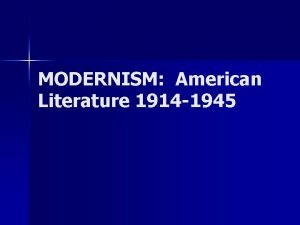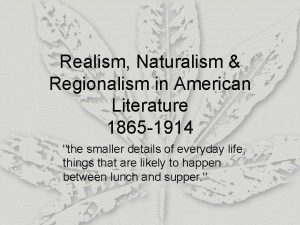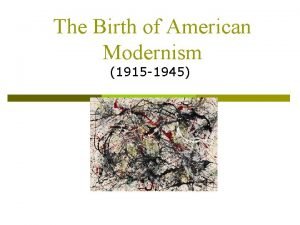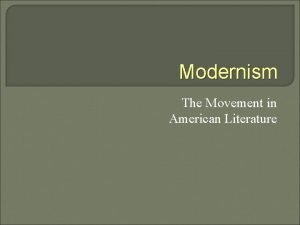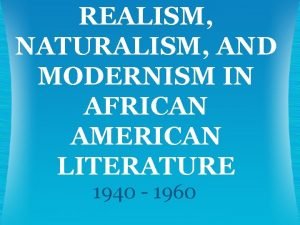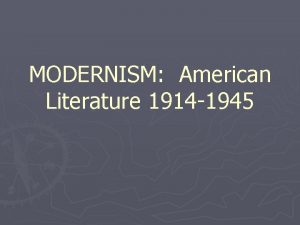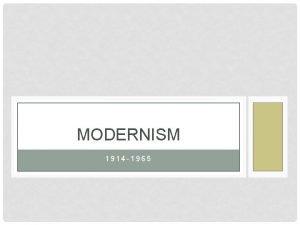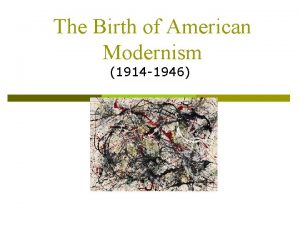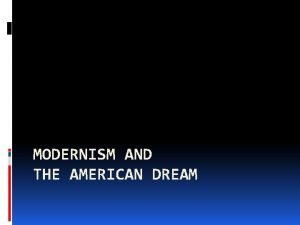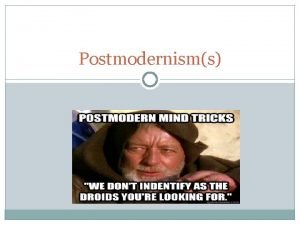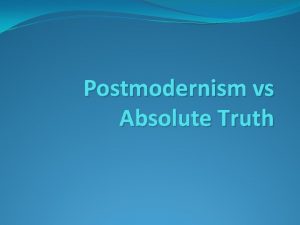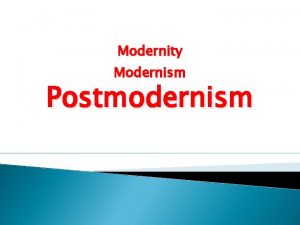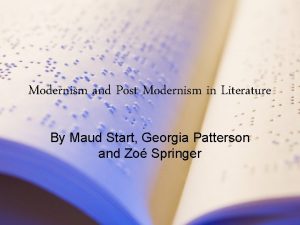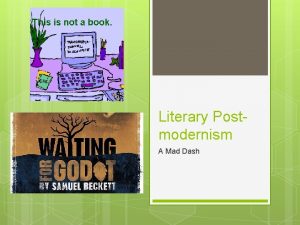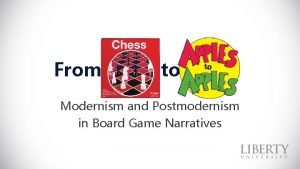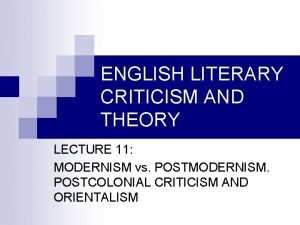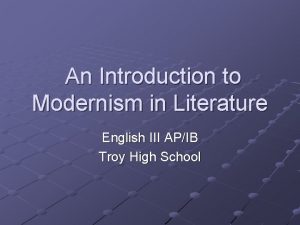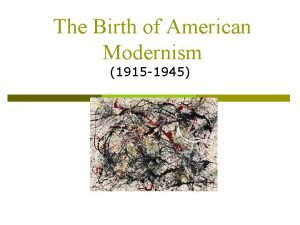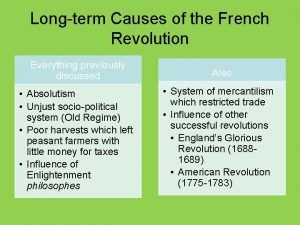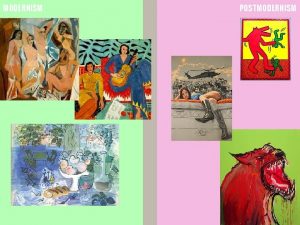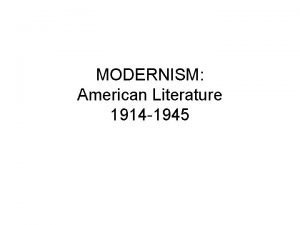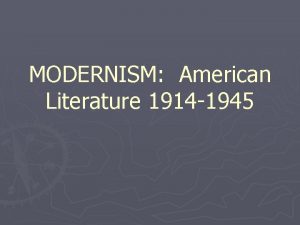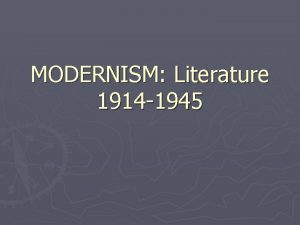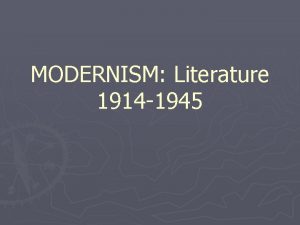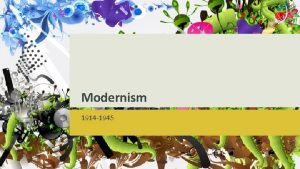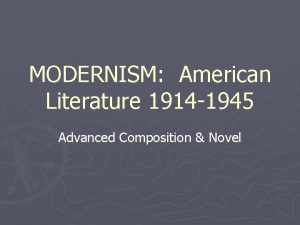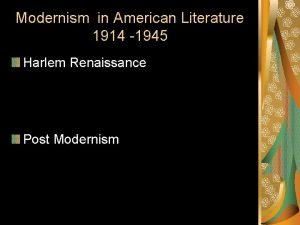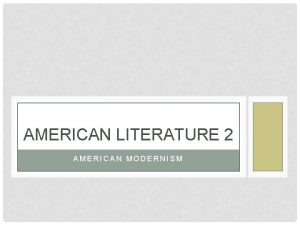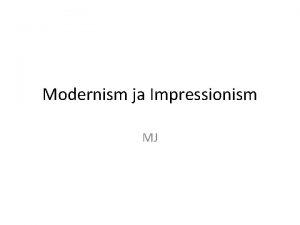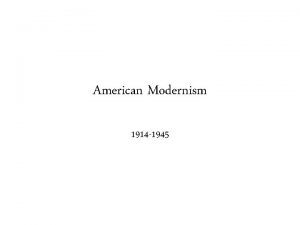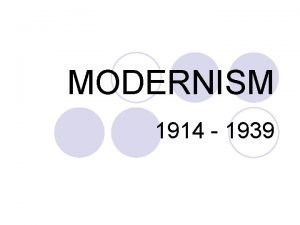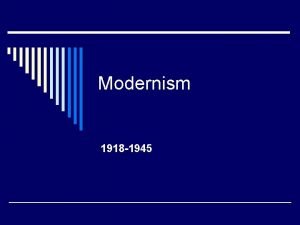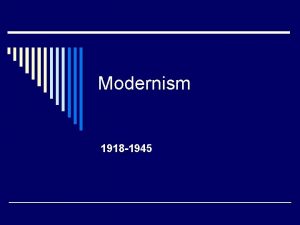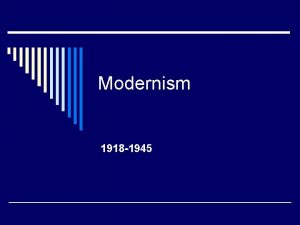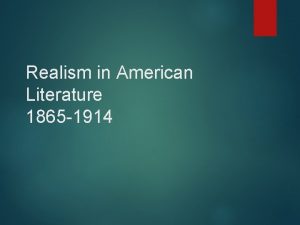MODERNISM American Literature 1914 1945 Causes of the
























- Slides: 24

MODERNISM: American Literature 1914 -1945

Causes of the Modernist Temper ► WWI ► Urbanization ► Industrialization ► Immigration ► Technological Evolution ► Growth of Modern Science ► Influence of Austrian Sigmund Freud (1856 -1939) ► Influence of German Karl Marx (1818 -1883)

WWI

URBANIZATION

INDUSTRIALIZATION

IMMIGRATION Oscar Handlin states, “Once I thought to write a history of the immigrants in America. Then I discovered that the immigrants were American history. ”

TECHNOLOGICAL EVOLUTION

GROWTH OF MODERN SCIENCE Scientists became aware that ► ► ► the atom was not the smallest unit of matter was not indestructible both time and space were relative to an observer’s position some phenomena were so small that attempts at measurement would alter them Some outcomes could be predicted only in terms of statistical probability the universe might be infinite in size and yet infinitely expanding

SIGMUND FREUD (1856 -1939) Invented the use of psychoanalysis as a means to study one’s “unconscious”

KARL MARX (1818 -1883) “The history of all hitherto existing society is the history of class struggles. ” “The development of Modern Industry, therefore, cuts from under its feet the very foundation on which the bourgeoisie produces and appropriates products. What the bourgeoisie therefore produces, above all, are its own grave-diggers. Its fall and the victory of the proletariat are equally inevitable. ”

INFLUENCES OF FREUD AND MARX ► Modernist writers concerned themselves with the inner being more than the social being and looked for ways to incorporate these new views into their writing. ► Modernist writers looked inside themselves for their answers instead of seeking truth, for example, through formal religion or the scientific presuppositions that realism and naturalism rested upon. ► Marxism instructed even non-Marxist artists that the individual was being lost in a mass society. ► Although Marx provided an analysis of human behavior opposed to Freud’s, both seemed to espouse a kind of determinism that, although counter to long-standing American beliefs in free will and free choice, also seemed better able to explain the terrible things that were happening in the twentieth century. ► Some modern writers believed that art should celebrate the working classes, attack capitalism, and forward revolutionary goals, while others believed that literature should be independent and non-political.

SHIFTS IN THE MODERN NATION ► from country to city ► from farm to factory ► from native born to new citizen ► introduction to “mass” culture (pop culture) ► continual movement ► split between science and the literary tradition (“science vs. letters”)

1920’s: THE JAZZ AGE To F. Scott Fitzgerald it was an “age of miracles, an age of art, an age of excess, an age of satire. ”

1930’s: THE DEPRESSION “True individual freedom cannot exist without economic security and independence. People who are hungry and out of a job are the stuff of which dictatorships are made. ” – Franklin D. Roosevelt

THE SPIRIT OF MODERNIST LITERATURE ► Conviction that the previously sustaining structures of human life, whether social, political, religious, or artistic, had been either destroyed or shown up as falsehoods or fantasies. Therefore, art had to be renovated. ► Modernist writing is marked by a strong and conscious break with tradition. It rejects traditional values and assumptions. ► “Modern” implies a historical discontinuity, a sense of alienation, loss, and despair. ► It rejects not only history but also the society of whose fabrication history is a record. Poetry tended to provide pessimistic cultural criticism or loftily reject social issues altogether. ► Writers exhibited a skeptical, apprehensive attitude toward pop culture; writers criticized and deplored its manipulative commercialism. ► Literature, especially poetry, becomes the place where the one meaningful activity, the search for meaning, is carried out; and therefore literature is, or should be, vitally important to society. Imaginative vision is thought to give access to an ideal world, apart and above reality, or to contain alternative, higher values than those reigning in the statehouse and the marketplace, which could enrich life. Furthermore, modernists believed that we create the world in the act of perceiving it.

CHARACTERISTICS OF MODERNIST WRITING ► ► ► ► A movement away from realism into abstractions A deliberate complexity, even to the point of elitism, forcing readers to be very well-educated in order to read these works A high degree of aesthetic self-consciousness Questions of what constitutes the nature of being A breaking with tradition and conventional modes of form, resulting in fragmentation and bold, highly innovative experimentation A variety in content because with a stable external world in question, subjectivity was ever more valued and accepted in literature Along with the social realist and proletarian prose of the 1920 s and 1930 s came a significant outpouring of political and protest poetry.

TECHNIQUES IN MODERNIST WORKS The modernists were highly conscious that they were being modern—that they were “making it new”—and this consciousness is manifest in the modernists’ radical use of a kind of formlessness. ► ► ► Collapsed plots Fragmentary techniques Shifts in perspective, voice, and tone Stream-of-consciousness point of view Associative techniques

COLLAPSED PLOTS ► It will seem to begin arbitrarily, to advance without explanation, and to end without resolution, consisting of vivid segments juxtaposed without cushioning or integrating transitions. ► It will suggest rather than assert, making use of symbols and images instead of statements. ► The reader must participate in the making of the poem or story by digging the coherent structure out that, on its surface, it seems to lack. Therefore, the search for meaning, even if it does not succeed, becomes meaningful in itself. ► Its rhetoric will be understated, ironic.

FRAGMENTARY TECHNIQUES ► Compared with earlier writing, modernist literature is notable for what it omits —the explanations, interpretations, connections, summaries, and distancing that provide continuity, perspective, and security in traditional literature. ► The idea of order, sequence, and unity in works of art is sometimes abandoned because they are now considered by writers as only expressions of a desire for coherence rather than actual reflections of reality. The long work will be an assemblage of fragments, the short work a carefully realized fragment. Some modernist literature registers more as a collage. This fragmentation in literature was meant to reflect the reality of the flux and fragmentation of one’s life. ► Fragments will be drawn from diverse areas of experience. Vignettes of contemporary life, chunks of popular culture, dream imagery, and symbolism drawn from the author’s private repertory of life experiences are also important. A work built from these various levels and kinds of material may move across time and space, shift from the public to the personal, and open literature as a field for every sort of concern.

SHIFTS IN PERSPECTIVE, VOICE, AND TONE ► The inclusion of all sorts of material previously deemed “unliterary” in works of high seriousness involved the use of language that would also previously have been thought improper, including representations of the speech of the uneducated and the inarticulate, the colloquial, slangy, and the popular. The traditional educated literary voice, conveying truth and culture, lost its authority. ► Prose writers strove for directness, compression, and vividness. They were sparing of words. The average novel became quite a bit shorter than it had been in the nineteenth century. ► Modern fiction tends to be written in the first person or to limit the reader to one character’s point of view on the action. This limitation accorded with the modernist sense that “truth” does not exist objectively but is the product of a personal interaction with reality. The selected point of view was often that of a naïve or marginal person—a child or an outsider—to convey better the reality of confusion rather than the myth of certainty.

STREAM-OF-CONSCIOUSNESS ► Stream-of-consciousness is a literary practice that attempts to depict the mental and emotional reactions of characters to external events, rather than the events themselves, through the practice of reproducing the unedited, continuous sequence of thoughts that run through a person’s head, most usually without punctuation or literary interference. ► The writers of the stream-of-consciousness novel seem to share certain common assumptions: § that the significant existence of human beings is to be found in their mentalemotional processes and not in the outside world, § that this mental-emotional life is disjointed and illogical, and § that a pattern of free psychological association rather than of logical relation determines the shifting sequence of thought and feeling ► The present day stream-of-consciousness novel is a product of Freudian psychology with its structure of subliminal levels.

ASSOCIATIVE TECHNIQUES ► Modernists sometimes used a collection of seemingly random impressions and literary, historical, philosophical, or religious allusions with which readers are expected to make the connections on their own. ► This reference to details of the past was a way of reminding readers of the old, lost coherence. ► T. S. Eliot’s The Waste Land is arguably the greatest example of this allusive manner of writing; it includes a variety of Buddhist, Christian, Greek, Judaic, German and occult references, among others.

SYMBOLISM ► ► ► Symbolists were a group of French poets who were active during the last thirty years of the 19 th century. Symbolism in France began as a revolt against the cold impersonality of the realistic novel and its minute descriptions of an objective, external reality. The rebel poets turned inward, in order to explore and express the shifting, subtle states of the human psyche. They believed that poetry should evoke and suggest, raising itself above the level of objective description only; hence, they sought poetic techniques that would make possible the recreation of human consciousness. The symbol and the metaphor enabled them to suggest mysterious and inexpressible subjective emotion. Often the symbols were highly personal, and their use resulted in obscure, esoteric verse. At its finest, however, symbolist poetry achieved a richness of meaning and created an awareness of the mystery at the heart of human existence. As symbolism sought freedom from rigidity in the selection of subject matter, so it desired to free poetry from the restrictions of conventional versification. The art that seemed most to resemble poetry was not that of sculptured precision of plastic forms but music; fluid melody and delicate lyricism characterized symbolist poetry. During the 20 th century the use of symbolism became a major force in British literature. T. S. Eliot adapted it in the development of his individual style and praised it in his criticism. The most outstanding development of symbolism was in the art of the novel.

Works Cited Baym, Nina, ed. The Norton Anthology of American Literature. New York: W. W. Norton & Company, Inc. , 1998. ► Harmon, William, and C. Hugh Homan, eds. A Handbook to Literature. New Jersey: Prentice-Hall, Inc. , 1996. ► Kimmelman, Burt, ed. The Facts on File Companion to 20 th Century American Poetry. New York: Facts on File, Inc. , 2005. ► Lathbury, Roger. American Modernism (1910 -1945): American ► Literature in its Historical, Cultural, and Social Contexts. Backgrounds to American Literature Series. New York: Facts On File, Inc. , 2006. ► Siepmann, Katherine Baker, ed. Benét’s Reader’s Encyclopedia. New York: Harper-Collins Publishers, Inc. , 1948.
 Realism vs modernism
Realism vs modernism Regionalism literary movement
Regionalism literary movement American modernist novels
American modernist novels Modernism in american literature
Modernism in american literature Realism naturalism modernism
Realism naturalism modernism Causes of modernism
Causes of modernism Modernism and the american dream
Modernism and the american dream Robert wohl
Robert wohl Modernism and the american dream
Modernism and the american dream Postmodernism vs modernism literature
Postmodernism vs modernism literature What is premodernism
What is premodernism Modernism timeline
Modernism timeline Modernism in literature
Modernism in literature Modernism characteristics literature
Modernism characteristics literature Post-modernism literature
Post-modernism literature Fragmentation literature
Fragmentation literature Postmodernism vs modernism literature
Postmodernism vs modernism literature Postmodernism vs modernism literature
Postmodernism vs modernism literature Introduction to modernism in literature
Introduction to modernism in literature What is modernism in literature
What is modernism in literature Ultimate and proximate causes of behaviour
Ultimate and proximate causes of behaviour Proximate causes vs ultimate causes
Proximate causes vs ultimate causes Main causes of the american revolution
Main causes of the american revolution American revolution strengths and weaknesses
American revolution strengths and weaknesses American revolution causes and effects
American revolution causes and effects
